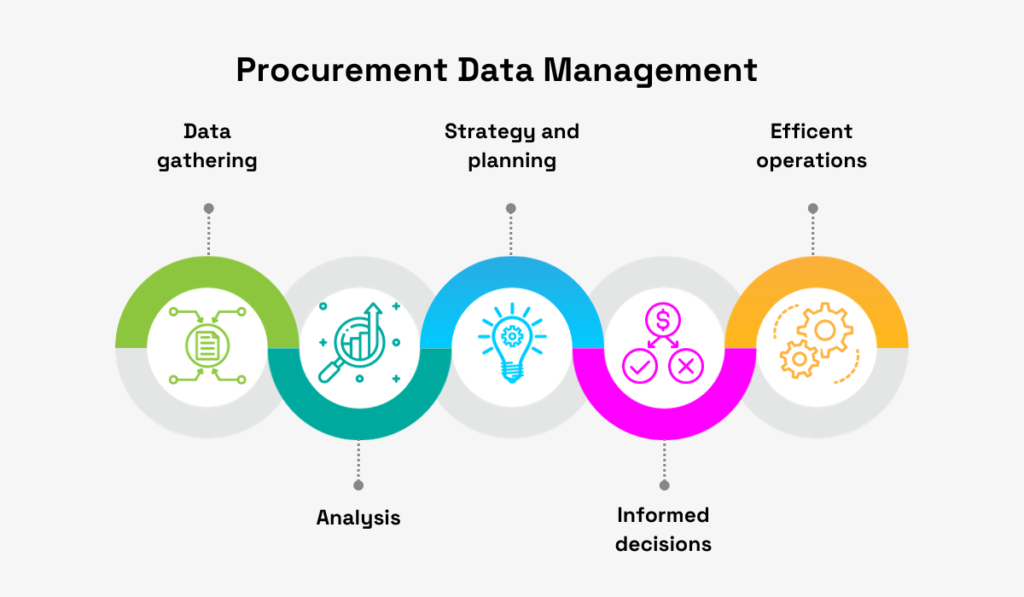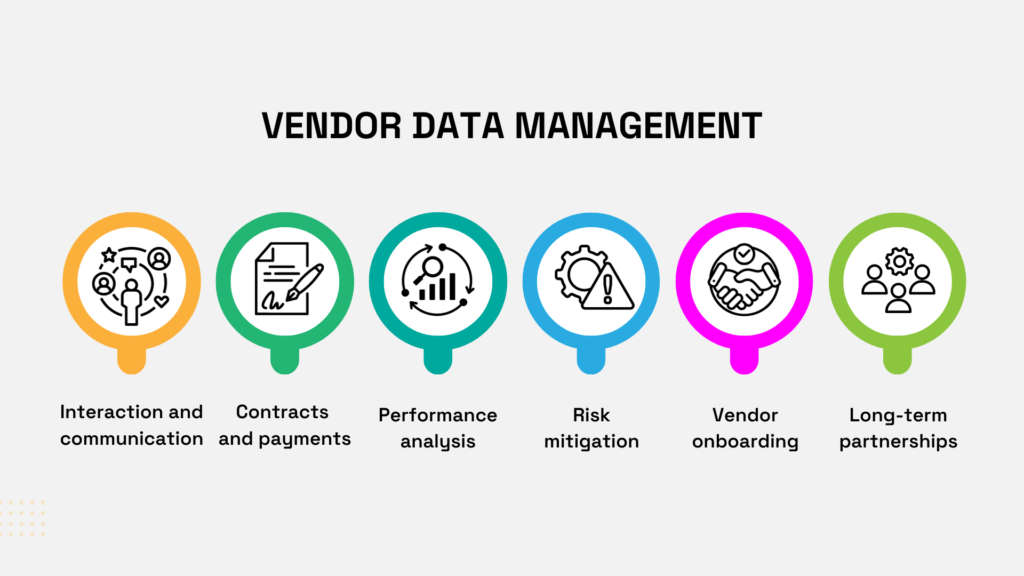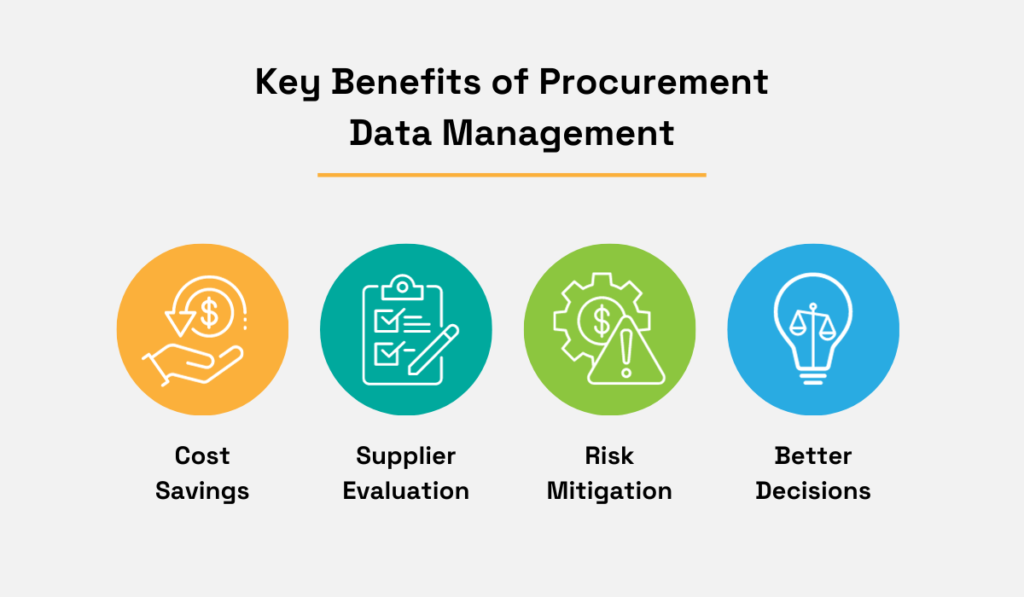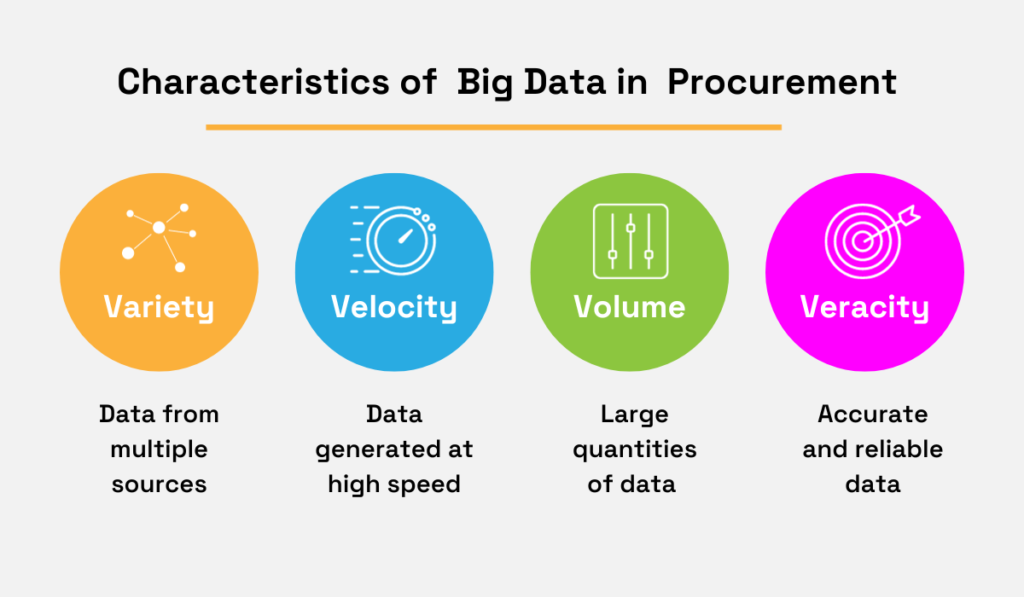The Ultimate Guide to Procurement Data Management


In today’s ever-evolving business landscape, where procurement is experiencing substantial transformations, the importance of procurement data and its management cannot be overstated.
Recognized as a critical asset, data is at the forefront of modern procurement practices.
The adoption of digital procurement data management signifies a strategic pivot that effectively addresses the constraints of the traditional procurement model.
This transformation is prompted by various factors, including the proliferation of big data and the rapid advancements in technology.
To keep pace with this growing trend, procurement leaders should leverage the power of actionable data and advanced analytics tools to shape more efficient sourcing and procurement strategies.
This comprehensive guide is made to shed light on the key components of procurement data management, providing you with valuable insights into what lies ahead and helping you stay competitive.
Let’s get started with the basics.
Procurement data management is the process of collecting, organizing, analyzing, and maintaining all the data related to the acquisition of products or services from external sources.
Since procurement goes beyond just buying goods, data management addresses every aspect of the process, ensuring, at the same time, that all relevant data is accessible, accurate, and actionable.
At the heart of data management is the process of gathering data such as supplier profiles, product specifications, cost-related information, contracts, and delivery times.
This also includes collecting up-to-date information about market changes, supplier’s business activity, sustainable practices, compliance, and much more.
This data is then structured, analyzed, and transformed into distilled reports that help procurement teams make better, data-driven decisions when sourcing products or services from suppliers.

Source: Veridion
While the concept is not a novelty, in our tech-driven era, procurement data management is continually evolving and gaining momentum.
Hence, efficient data management uses the right technology at each stage—from collecting and storing to analyzing and reporting on procurement data.
But we’ll get to that a bit later.
The key thing is, in an environment where the volume, range, and speed of data are exponentially growing, navigating the world of data without a robust data management system would be exceedingly challenging, if not impossible.
In any organization, both procurement and vendor management are essential functions.
While closely aligned and working towards a shared goal, they differ in scope and purpose.
Procurement data management collects, organizes, and handles all information related to the entire procurement process.
This includes a broad range of data elements, such as purchase orders, invoices, contract terms, spend analytics, and more.
On the other hand, vendor data management is more of a subset of procurement data management.
It focuses on managing the information specifically related to suppliers, like contact information, their financial stability, quality performance, compliance records, relationship data, etc.

Source: Veridion
These two data management processes also differ in purpose.
While procurement data management aims to optimize the entire procurement process, vendor data management primarily facilitates good supplier relationships and performance valuations.
The procurement function has evolved from being mainly focused on purchasing into a strategic player providing critical data-driven insights to executive leadership.
And this is all thanks to the available data.
Procurement data management is all about using data analytics to gain valuable insights that will allow for optimized procurement strategies, smarter decision-making, and more accurate forecasting.
First and foremost, implementing an automated data management system significantly cuts costs related to manual labor.
The time your procurement team spends researching potential suppliers will decrease to less than a third.
As Chris Sawchuk, Principal of The Hackett Group, explains:
Smart automation can reduce operating costs, and eliminate transactional work, freeing up staff time for more value-added efforts.
It also empowers procurement specialists to seamlessly compare prices and find the most cost-effective supplier for their needs.
By leveraging market data analysis, companies can identify potential areas for cost savings, and negotiate more favorable terms with suppliers.
Furthermore, procurement data management assists the process of evaluating supplier performance by providing better visibility into each stage of the supply chain, including tracking orders, and ensuring that goods or services are delivered on time.
In other words, access to actionable data empowers procurement executives to uphold broad insight into supplier performance results.

Source: Veridion
Another field where data management excels is in assessing and mitigating risks.
Collecting procurement data is crucial for safeguarding your organization and improving risk management.
And that’s important because the risks related to supply and procurement are on the rise, and have been for a while, according to the latest Deloitte Global Chief Procurement Officer Survey.
To put an even finer point on it, in the 2023 study, 43% of CPOs reported a significant increase of the risks related to procurement, which is particularly notable in light of the fact that in the 2021 study, that percentage was only 20%.
So how does data management help here?
Well, for starters, data based analysis can predict changes in the supply chain, identify single-source items, and monitor key suppliers’ financial stability.
Moreover, making data-based procurement decisions helps mitigate risks associated with human bias.
Not just that, the data-centric procurement approach empowers procurement specialists to identify emerging patterns, trends, and opportunities, and make more accurate procurement planning and forecasting.
This efficiency is vital for executives aiming to make procurement a driving force in their business’s success.
The success of procurement data management depends on its structure.
To ensure effectiveness, the system must incorporate several critical components—from data identification and collection to analysis and quality assurance to data security.

Source: Veridion
In the following sections, we’ll go through what it takes to get started on procurement data management.
To initiate the implementation of a data management system, procurement professionals should first figure out what data they need to collect and store in order to meet their procurement goals.
Identifying the right data ensures that the procurement process is efficient and aligned with the organization’s overall objectives.
Collecting data is a crucial aspect of procurement data management. It involves acquiring information from a variety of sources.
By using various software solutions that automatically collect data, organizations ensure that the data they rely on is accurate, complete, and up to date.
This efficient practice of data collection helps create comprehensive and consistent datasets that support effective data analysis.
This component of data management focuses on organizing, categorizing, and storing data in a structured manner that will allow easy access, retrieval, and analysis.
Data is organized in logical data models, such as databases or data lakes, with a clear structure that enables users to quickly run data queries.
On top of that, advanced data classification methods and data lineage are necessary for proper documentation and compliance with rules and regulations.
Effective data organization integrates diverse data sources into one central structured database, enabling simplified data access and usability.
Raw data holds minimal value until it is thoroughly analyzed, contextualized, and put into action.
Examples range from analyzing historical spend data and market dynamics to using advanced analytics to guide future budgeting decisions.
This is where a supplier sourcing enablement tool like Veridion excels in efficiency.
Namely, the system actively analyzes extensive datasets, offering clear insights into supplier data, and revealing useful patterns and market trends.

Source: Veridion
Data analysis is an essential part of procurement data management as it can help identify cost-saving opportunities, evaluate the performance of suppliers, pinpoint and mitigate risks in the supply chain, and assist with demand forecasting.
This aspect of data management is focused on ensuring that the data which the organizations are using is accurate, up-to-date, and reliable.
To achieve this, the data needs to be cleaned, which involves a systematic process of reviewing, validating, and modifying to ensure high quality and integrity.
Veridion’s Match & Enrich capability provides an automated solution to this challenge. It enables businesses to keep their Supplier Master Record (SMR) and Master Data Management (MDM) updated, de-duplicated, and real-time, thereby providing them with the most accurate view of the supplier landscape.
Procurement activities involve exchanging of sensitive and confidential information, including supplier contracts, financial statements, and spend data.
This is the reason why data security is a crucial component of data management and businesses’ top priority.
The first step in this direction is to have robust data encryption protocols, along with other cyber-security measures such as firewalls and antivirus software.
An equally crucial step is to regularly back up the database, preventing data loss, corruption, or damage.
Database backups enable the recovery of data before it becomes unusable.
Another way to enhance data security is to restrict data access to authorized individuals only.
Limiting data access to a small group of people on a need-to-know basis significantly reduces the risk of accidental data exposure or mishandling.
Data management relies upon the advantages offered by various digital tools, which help keep the procurement process organized and streamlined.
To that point, selecting the right technology can be a game-changer in your journey towards data-driven procurement.
Whether it’s a powerful database system or an advanced data analytics tool, the choice should match your specific business needs and overall data management strategy.
Here are some of the tools that can be used for procurement data management.
Procurement software is a cloud-based solution that digitally manages a supply chain by hosting all the steps of the procurement process in one central system.
It allows companies to properly manage their procurement cycle by comparing purchasing options, handling purchase orders and billing, and managing supplier relationships.
Procurement software can encompass different modules, such as Enterprise Resource Planning (ERP) systems or creating digital catalogs of products and services.
However, ERP systems or digital catalogs alone are no longer sufficient to keep up with evolving business needs, prompting companies to employ additional solutions to respond to the changing business landscape.
Nonetheless, these software solutions can serve as a reliable source of data for subsequent analysis.
Big data has completely shifted the notion of leveraging information, particularly in procurement and supply chain management, opening a whole new world of opportunities.
Known for its capability to bring together, combine, and analyze a large volume of data arriving at high speed from various sources, both internal (like ERPs) and external (like third-party data providers), it transforms this diverse data into valuable insights.
Therefore, big data is characterized by four Vs, as shown in the image below:

Source: Veridion
Veridion is a platform that brings big data and analytics to your doorstep.
It’s sourcing data from various sources such as companies’ websites, social media, and the press to make data as accurate and near-time as possible, all at a global scale.
Furthermore, powered by ML and AI automation, it provides access to a vast network of over 70 million suppliers worldwide.
In essence, the growing application of big data and analytics empowers procurement teams with readily accessible knowledge in the blink of an eye.
Data analytics platforms are used to analyze and interpret large volumes of data using cloud computing resources, allowing organizations to process extensive datasets more easily.
They include integrated tools for machine learning, artificial intelligence, and other advanced analytical techniques designed to extract deeper insights from available data.
Unlike manual data analysis, these platforms bring results almost instantly—facilitating faster response times and enhancing decision-making throughout the organization.
At last, business intelligence tools help transform analyzed data and relevant insights into visual presentations and reports, making the data more readable.
Instead of diving into countless rows and columns of Excel spreadsheets, these smart technologies bring the most efficient methods for data management.
The resulting charts and tables can be effortlessly shared through a dynamic dashboard, enabling anyone in the company to view, understand, and participate in the data extraction process.
Modern business intelligence solutions in procurement enable procurement specialists to leverage the potential of the collected information, bringing significant advantages and control over countless pieces of information.
So there you have it.
Now you know the most important things about data management in procurement. You know the basics, the benefits, the components and the tools you might need.
The bottom line is that modern procurement needs modern solutions.
By bringing smart tools into the picture, consolidating data and acting upon it is no longer a task of traditional means but an essential part of strategic procurement processes.
Take this as a final thought: You can trust your gut instincts but bet on technology.